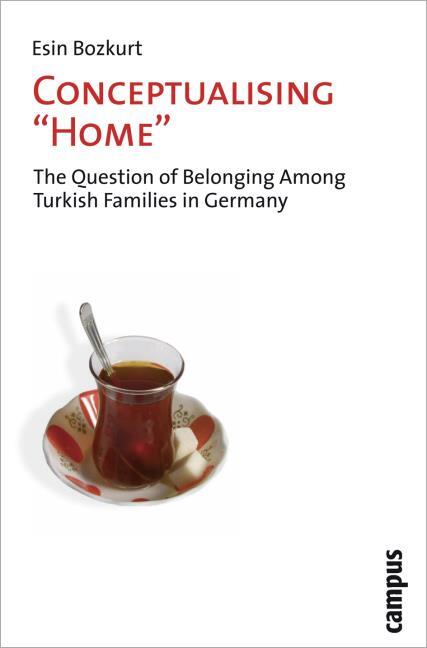Conceptualising Home
The Question of Belonging Among Turkish Families in Germany
| ISBN/EAN: | 9783593387918 |
|---|---|
| Sprache: | Englisch |
| Umfang: | 243 S. |
| Einband: | Paperback |
Erschienen am
02.03.2009
Sechs türkische Familien in Deutschland sprechen über ihre Vorstellungen von Heimat. Frauen und Männer aus drei Generationen schildern, wo sie sich ethnisch, kulturell, religiös und national zugehörig fühlen. Die individuellen Migrationserfahrungen und Lebensumstände führen zu vielfältigen Formen der Selbstverortung. Einmal mehr wird hier deutlich, wie eng Integration, Identifikation und Anerkennung miteinander verknüpft sind.
Esin Bozkurt, Dr. rer. pol., studierte in Istanbul Psychologie, Soziologie und Kultursoziologie und promovierte an der Universität Bremen.
Key themes structuring the studies on Turkish migrant women in Germany have been that of the uncivilized stranger and the victim of patriarchal honour (Inowlocki and Lutz 2000; 307). Social research, policy and public discourse converged to construct a homogenized image of women with Turkish background as backward, isolated and needy people with low decision-making power in the family, and Turkish men as patriarchs (Herwatz-Emden and Westphal 1997; Sechster Familienbericht 2000). Especially early period studies employed a stereotypical perspective and depicted Turkish women as oppressed, obedient and weak individuals, and Turkish men as violent domineering people. Continuous citations of these studies strengthened negative pictures. They were used to legitimate ethnic differences and sharpened the boundaries between the majority society and migrants (Tunc 2006). Feminist research on migrant women during the last two decades contributed hugely to deconstruct these representations. A path-breaking work has been Helma Lutz's (1986) study on Turkish social workers in Germany and Netherlands, which challenged the assumption that Muslim women's identity and behaviour can be explained on the basis of their culture of origin, narrowly defined as religious, rustic and traditionally patriarchal. Moreover, Berrin Özlem Otyakmaz's (1995) study on Turkish women from the second generation; Margaret Spohn's (2002) research on the first generation of Turkish men in Germany criticising stereotypical depictions in the literature, especially in early period research; Yasemin Karakasoglu and Ursula Boos-Nünning's (2005) study on young women with immigration background; Werner Schiffauer's (2002) study on migration and cultural difference pointing at the feminist discourse against violence, arranged marriages and gendered division of labour in the narratives of "self-conscious Muslim women" (p.24) all constituted significant steps in the field and contributed to the opening/enlargement of the research perspective. 3.2. Gendered facets of Turkish migration to Germany A look at the history of migration from Turkey demonstrates the inaccuracy of the predominant image of Turkish women constructed by early studies. As opposed to the common opinion, migrant women of Turkish origin who arrived after 1960s were mostly skilled and educated women coming from urban areas of Turkey. Especially after the economic recessions in West Germany in 1966 and 1967, job prospects for men got worse and the demand for women workers grew. Traditional gender roles and stereotypical images regarding the place of women in society influenced the type of work for which migrant female labour was recruited. Accordingly, women, who were admitted as workers concentrated in "female occupations" such as small manufacturing industries, textile, tailoring, food processing, packaging and cleaning (Toksöz 1992). German companies increasingly employed women as reliable sources of cheap female labour and reproduced an ethnically structured and gendered labour market (Anthias 2003). It was mostly in the second phase of migration starting in early 1970s that women from rural areas started to arrive in Germany. Main migration motivations of these women were economic improvement, education, training, political refuge, escape from unsatisfactory marriages, the pressure of tradition, family reunification and marriage migration (Ilkkaracan 1996; Erman 1998). It would not be correct to assume that all women emigrating for marriage purposes or joining their husbands stayed as housewives in Germany. The desire to speed up the process of money accumulation for an earlier return to the homeland was an important motivation for some emigrant women to participate to the labour market (Dietzel-Papakyriakou 1990; Mihciyazgan 1992). However, not all emigrant women had the chance to work. Some were hindered by language problems, familial and institutional constraints or limited access to supportive social networks. These constraints led to social isolation, economic dependence and inequalities in the exercise of domestic labour. In certain situations, emigration strengthened women's home-making role by pushing them to become housewives (Ilkkaracan and Ilkkaracan 1998) in contrast to their pre-migration status. As argued by Sibley (1995), the house might become a place in which women's options are seriously restricted, considered that the conflicting aspects of domestic life and the tensions surrounding the use of domestic space may lead to questions of oppression, exploitation and violence in houses. According to Karen Fog Olwig (1999), we must recognize that home (in the sense of a place/house) is often "a contested domain: an arena where differing interests struggle to define their own spaces within which to localise and cultivate their identity" (cited in Morley 2000, 57). This arena may become "a place of exclusion, segregation, hierarchy and violence" for some people (Hörder 2005, 15), who are demonstrated to be women mostly. Fortunately however, above described conflicts, oppressions, isolations and closure processes do not constitute the only possibility. Emigrant women also encounter new opportunities for education, training or employment in the hostland, which contribute to the re-conceptualisation of gender roles and the challenging of gender hierarchies (Kurosch 1990). Those who are employed benefit most from these opportunities, because labour market participation affects the female "normal biography" (Levy 1991), plays a dominant role in structuring women's life courses, and transforms gender roles and gender relations (Krüger 2001b). Especially for those women coming from rural areas and large households where they live under the strict control of senior family members, emigration refers to the liberation from traditional/patriarchal forms of authority, the social pressure of the community (Schiffauer 2003, 2005c), and everyday arrangements of a large family. Moreover, it refers to a movement towards financial independence, to increasing decision-making power and autonomy (Clifford 1997; Morley 2000), and control over economic resources. Transformations in migrant women's new economic roles and their contributions to family income change their position in families and in wider migrant community, and challenges gender hierarchies. This is reported to cause a positive shift in the relationship between migrant women and their husbands. In his study on emigrants from Subay, Schiffauer (1991) reports that with the emigration from the rural area in Turkey to the urban space in Germany, first generation of Turkish migrants developed new structures of subjectivity, which are shaped by migration-specific terms and conditions, transforming the relationship between the couples and giving them a more personal, intimate and egalitarian character. Similar observations are reported by Nermin Abadan-Unat (1977) and Barbara Wolbert (1995) stressing that the most important change has taken place in the relationship between couples and the decision-making process in the family. Changes in women's and men's lives with women's post-migration employment contribute to the transformation of gender relations and the weakening of gender hierarchies among Turkish migrant couples. However, the same transformations might become conflicting experiences for women who have difficulties in reconciling traditional gender roles of their home culture with the demands of participation to a new socio-cultural environment. Especially in case of a sharp difference between home and host cultures, the difficulty to find an adequate strategy with which to counter and balance contradictory demands of tradition and progress might grow (Gillespie 1995; Gray 2004). In such a situation, women might adapt to new structures by remaining attached to the home culture selectively. They might experience this condition as a process of connecting-disc...
Table of Contents
Acknowledgements
Introduction
1 Migration and belonging
1.1 Defining home across three socio-linguistic contexts
Home and homeland in Turkish context - Home and homeland in German context - Related concepts
1.2 Mobility and home
Migration, resettlement and the making of home - Reconceptualising home
2 Contextualising "home": Turkish immigrants in Germany
2.1 Turkish migration to Germany
Migration and resettlement - Migrancy, longing and belonging - Religious home-making abroad - Crystallisation of belongings -Conclusions and open questions
2.2 Children of Turkish emigrants in the literature
Experiences with exclusion - Finding feet in the battlefield - Spatial and cultural references - Religious belonging consolidated and transformed - Sympathetic others and suffering companions - Conclusions and open questions
3 Gender, migration and belonging
3.1 The question of gender in migration research
3.2 Gendered facets of Turkish migration to Germany
3.3 Women and home
3.4 Conclusions and outlook
4 Empirical Research
4.1 Recapitulating research objectives
4.2 Research questions
4.3 Research methods
Qualitative research: Problem-centred interviews - In the field - Access to the sample - Introducing families - Conducting interviews - The language of interviews - The transcription of interviews - Data analysis
5 The question of belonging across three generations
5.1 From guests to commuters: The first generation
The experience of migration - Loss of status - Temporality - The making of home as a guest -Conclusions: From a airy home to a heavy life
5.2 Claiming home: The second generation
The profile of the second generation - From Turkey to Germany - Schooling in Germany: Initial Difficulties - Experiences in Germany and changing relations with Turkey - Difference and exclusion - Back at home as a guest - The question of belonging - Conclusions: Questioning home as children of the first generation and parents of the third generation
5.3 Fighting for belonging: The third generation
The profile of the third generation in the sample - Living and grounding in Germany with backups and emergency exits - Escape from reality, sheltering in roots - Dealing with the present: Reborn Turks, Muslims and other Others - Conclusions: Incomplete lives, substitute homes
6 Gendered (re)constructions of "home": Turkish men and women in Germany
6.1 Gender in migration process
Gender differences in the experience of migration - Employment of Turkish women - Experiences in Germany and in Turkey
6.2 Gendered (re)constructions of home
Home as conceptualised by women - Home as conceptualised by men
6.3 Gendered return orientations
6.4 Conclusions
7 Belonging at the crossroads of gender and generations
7.1 Common themes and shared patterns of intergenerational communications across six turkish families
7.2 Differences across families: Changing emphases on culture, nation and religion
7.3 Gendered communication of belonging across generations
Women and communication - Men and communication
7.4 Conclusions
Conclusion
List of Tables
Bibliography
Appendix


